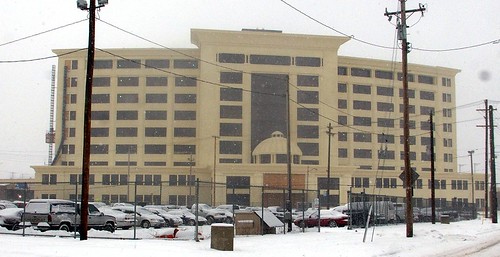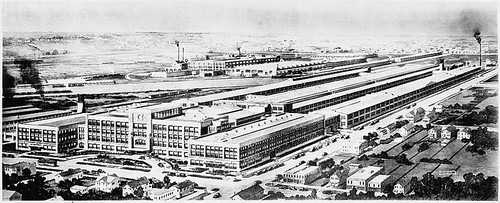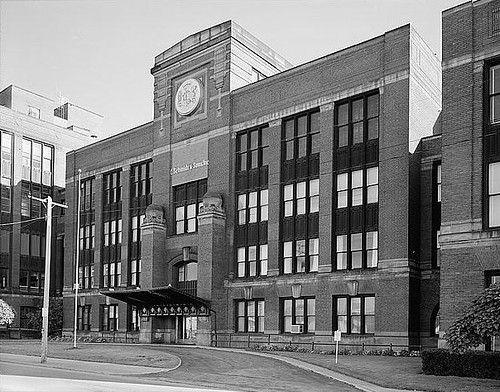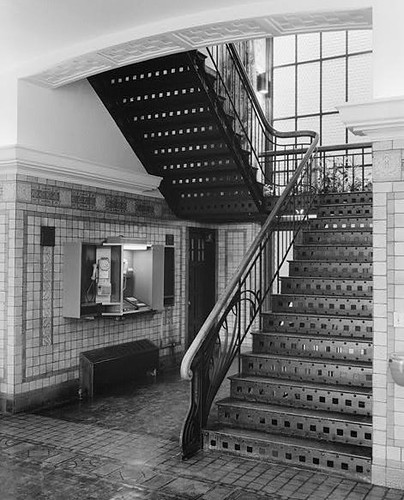
By now, you've probably heard about the new Cuyahoga County Juvenile Justice Center, under construction at the southeast corner of Quincy Avenue and East 93rd Street, in the Fairfax neighborhood of Cleveland. Little has been said, however, about the previous uses of the site.
In 1906, the Peerless Motor Car Company, one of the finest manufacturers of automobiles in the country, built a factory on this site. Architect J. Milon Dyer designed the factory. Dyer was also responsible for the Cleveland Coast Guard Station, the Cleveland City Hall, the Tavern Club, and the Brown-Hoist building.

The factory, seen here in an early 20th century view, stretched all the way to Woodland Avenue. While the portions of the factory between Quincy and the train tracks have been demolished, some structures remain between the tracks and Woodland.
The following photographs, created by the Historic American Buildings Survey, illustrate the history of this complex.

1979, Jet Lowe for the Historic American Buildings Survey
The factory's office building, shown here, faced Quincy Avenue. Dyer's work on the structure received considerable praise.
Its "front of attractive design" showed the influence of Frank Lloyd Wright in its geometric stone ornament and globe-capped pylons and of the Art Nouveau in its metal and glass entrance canopy and doors. Architecturally, the office building was "25 years ahead of its day."

February 28, 1966, Martin Lindsey for the Historic American Buildings Survey
The aesthetic quality continued to the interior. The Art Nouveau influence is especially visible in the railing on this set of stairs.
In 1931 Peerless closed its business, unable to find a market for luxury cars during the depression. The business was reorganized and eventually became the Carling Brewing Company. The automobile factory was repurposed as a brewery, which operated until 1971. C. Schmidt & Sons, purchased the brewery and ran its operations from the plant from 1972-84.
Most of the complex was demolished in the late 1980s or early 1990s. The Historic American Buildgs Survey has two sets of documentation regarding the factory. Their documentation addresses the history of the structure and of the Peerless operations in Cleveland in detail.




What a loss. The new juvi doesn't hold a candle to this.
ReplyDeleteI drove down Quincy the other day and noted how smooth the road is all the way to the bridge crossing at around E71 where I had to detour for a few blocks. Woodland could use the same treatment. Maybe then doctors and nurses could easily find their way from E55 and I-490 without us having to spend $375 million for a new road. It is easier for businesses and gardens to spring up along these routes as well without disruption. That area is really quite lovely especially around the cemeteries and it's the best way to get to a highway or downtown if you live in Shaker. Why everyone insists on using Carnegie is a mystery to me. Maybe we're just trying to experience traffic congestion.
Any other historic buildings along that route we should be aware of before they plan to tear them down? One of my favorites on Larchmere on the escarpment is the Woodhill Estates with the tiles by Edris Eckhardt.
ODOT will always look for ways to fix problems, real or perceived, with the transportation system. It's the nature of any govermental body - if they don't keep coming up with new projects, there will be funding and budget cuts. As a result, they try to act in a way that they believe best serves the largest number of people.
ReplyDeleteAs for the idea of using Woodland as a connector between 490 and the Clinic, there are two major bottlenecks: East 55th Street and East 105th Street.
Finally, I suspect it has something to do with the fact that people from the suburbs don't want to have to look at public housing projects. My solution to that problem would be to put more money into design and architectural detail on said construction, but that's another matter.
Why does E 55th have to be a bottleneck? We use the Carnegie-to-55th route whenever we need to get to 71, 77 or 90-W from the Cedar-Fairmount area. It seems like a far better use of funds to improve 55th and the timing of its traffic lights (and what's with the left turn arrow onto Cedar from southbound 55th anyway? A relic of the repaving of Carnegie when traffic was routed to Cedar?) than to cut a new roadway, disturbing neighborhoods.
ReplyDelete